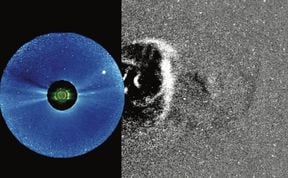Space Weather

Solar wind driving of space weather
Prof. Tuija Pulkkinen (elec.aalto.fi)
The continuous, highly variable solar wind flows through the heliosphere and drives space weather in space environments of the Earth and other planets. The solar wind influence on the magnetosphere is not instantaneous; solar wind properties are altered at the bow shock and further modified in the magnetosheath between the shock and the magnetospheric boundary. The magnetosheath plasma and magnetic field determine the efficiency of mechanisms governing solar wind energy and plasma entry to the magneto-sphere: magnetic reconnection, Kelvin-Helmholtz instability, and kinetic Alfvén waves. Within hours, the coupling leads to magnetotail reconfigurations and over days, acceleration of relativistic electrons in the van Allen belts.
Increasing evidence suggests that interplanetary magnetic field fluctuations enhance the solar wind–magnetosphere coupling efficiency: A significant portion of the largest magnetospheric disturbances are associated with turbulent sheath regions, fluctuating stream interaction regions drive radiation belt electron enhancements, and strong ULF waves are associated with strong ionospheric convection. We use space observations and numerical modeling methods to investigate how the solar wind and interplanetary magnetic field and their variability drive geomagnetic activity in the magnetotail, in the inner magnetosphere, and in the ionosphere.
Two Radiation Belt Storm Probes (RBSP) (nasa.gov), were launched on Aug 30, 2012 to the inner magnetosphere to monitor the ring current and radiation belts. The European four Cluster (sci.esa.int) craft have been in orbit since 2000 and the NASA Five Themis(nasa.gov) spacecraft since 2007 providing an unprecedented opportunity of frequent simultaneous measurements from the near-Earth solar wind, shocked magnetosheath plasma, and consequences in the magnetotail and inner magnetosphere.
Local and global magnetohydrodynamic simulations are used to examine the plasma transport and dynamic processes in the magnetosphere. While the local models can address many details of the instability development, the global simulations address the large-scale dynamics of the entire system. The GUMICS global MHD simulation developed in Finland is one of 5 actively used simulations globally, and the only one in Europe.
The increased dependence of modern society on space technology has generated a need for targeted space weather studies, which aim at predicting the space environment and estimating worst-case scenarios for technology development and asset protection purposes.
Research is carried out in collaboration with the University of Helsinki (physics.helsinki.fi) and the Finnish Meteorological Institute (en.ilmatieteenlaitos.fi) under the auspices of the Kumpula Space Centre.
Figure: Kilpua et al. 2009
Group members
Latest publications
Solar Intensity X-Ray and Particle Spectrometer SIXS: Instrument Design and First Results
Oxygen Ion Escape from Venus is Modulated by Ultra-Low-Frequency Waves
Ultra-low frequency waves in the ion foreshock of Mercury: A global hybrid modeling study
Hybrid modeling of cometary plasma environments
Planetary magnetic field control of ion escape from weakly magnetized planets
Stellar Influence on Heavy Ion Escape from Unmagnetized Exoplanets
Properties of Magnetic Reconnection and FTEs on the Dayside Magnetopause With and Without Positive IMF Bx Component During Southward IMF
GUMICS-4 analysis of interplanetary coronal mass ejection impact on Earth during low and typical Mach number solar winds
Remote Sensing of a Bow Shock at Comet 67P: ICA and Hybrid Modelling
Remote Sensing of a Bow Shock at Comet 67P: Theory, ICA Observations and Hybrid Modelling
Contact:
Professor Tuija Pulkkinen
Email: tuija.pulkkinen at aalto.fi
Tel.: +358 50 5916 013
Postal address:
Department of Electronics and Nanoengineering
Aalto University School of Electrical Engineering
P.O. Box 15500, 00076 Aalto, Finland
Visiting address:
TuAs-building
Maarintie 8, 02150 Espoo